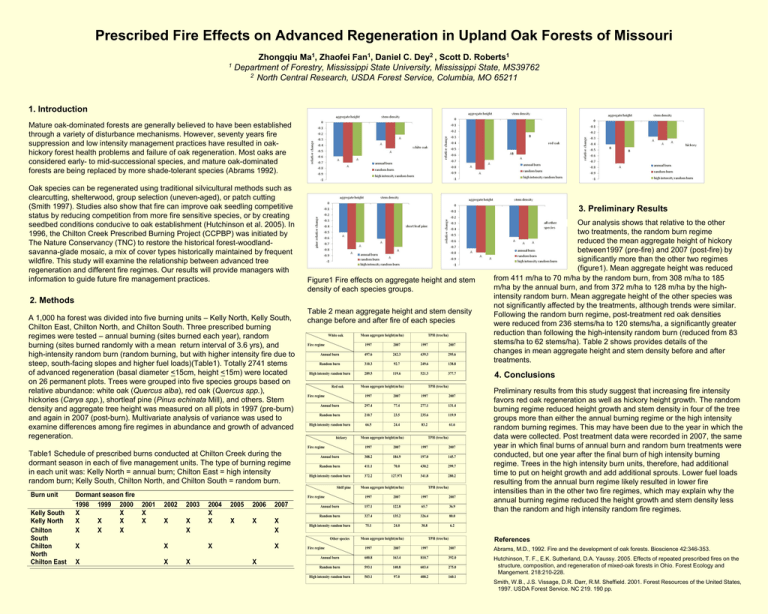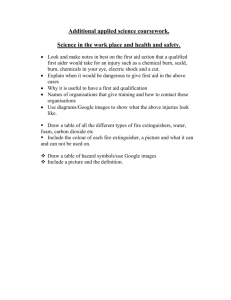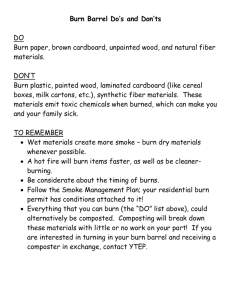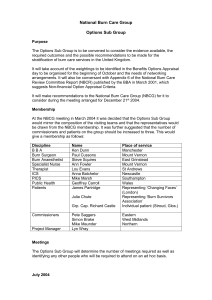Zhongqiu Ma , Zhaofei Fan , Daniel C. Dey , Scott D. Roberts
advertisement

Prescribed Fire Effects on Advanced Regeneration in Upland Oak Forests of Missouri Zhongqiu Ma1, Zhaofei Fan1, Daniel C. Dey2 , Scott D. Roberts1 1 Department of Forestry, Mississippi State University, Mississippi State, MS39762 2 North Central Research, USDA Forest Service, Columbia, MO 65211 1. Introduction Mature oak-dominated forests are generally believed to have been established through a variety of disturbance mechanisms. However, seventy years fire suppression and low intensity management practices have resulted in oakhickory forest health problems and failure of oak regeneration. Most oaks are considered early- to mid-successional species, and mature oak-dominated forests are being replaced by more shade-tolerant species (Abrams 1992). Oak species can be regenerated using traditional silvicultural methods such as clearcutting, shelterwood, group selection (uneven-aged), or patch cutting (Smith 1997). Studies also show that fire can improve oak seedling competitive status by reducing competition from more fire sensitive species, or by creating seedbed conditions conducive to oak establishment (Hutchinson et al. 2005). In 1996, the Chilton Creek Prescribed Burning Project (CCPBP) was initiated by The Nature Conservancy (TNC) to restore the historical forest-woodlandsavanna-glade mosaic, a mix of cover types historically maintained by frequent wildfire. This study will examine the relationship between advanced tree regeneration and different fire regimes. Our results will provide managers with information to guide future fire management practices. 3. Preliminary Results Figure1 Fire effects on aggregate height and stem density of each species groups. 2. Methods A 1,000 ha forest was divided into five burning units – Kelly North, Kelly South, Chilton East, Chilton North, and Chilton South. Three prescribed burning regimes were tested – annual burning (sites burned each year), random burning (sites burned randomly with a mean return interval of 3.6 yrs), and high-intensity random burn (random burning, but with higher intensity fire due to steep, south-facing slopes and higher fuel loads)(Table1). Totally 2741 stems of advanced regeneration (basal diameter <15cm, height <15m) were located on 26 permanent plots. Trees were grouped into five species groups based on relative abundance: white oak (Quercus alba), red oak (Quercus spp.), hickories (Carya spp.), shortleaf pine (Pinus echinata Mill), and others. Stem density and aggregate tree height was measured on all plots in 1997 (pre-burn) and again in 2007 (post-burn). Multivariate analysis of variance was used to examine differences among fire regimes in abundance and growth of advanced regeneration. Table 2 mean aggregate height and stem density change before and after fire of each species White oak Fire regime 2007 1997 2007 Annual burn 497.6 242.3 439.3 295.6 Random burn 310.3 92.7 249.6 138.8 High intensity random burn 289.5 119.6 521.3 377.7 Red oak Fire regime Kelly South Kelly North Chilton South Chilton North Chilton East Dormant season fire 1998 1999 2000 X X X X X X X X 2002 X 2003 X X 2004 X X 2005 X 2006 X 2007 X X 1997 2007 Annual burn 297.4 77.4 277.1 131.4 Random burn 210.7 23.5 235.6 119.9 High intensity random burn 66.5 24.4 83.2 61.6 hickory X X X X X X X Mean aggregate height(m/ha) TPH (tree/ha) 1997 2007 1997 2007 Annual burn 308.2 184.9 197.0 145.7 Random burn 411.1 70.0 430.2 299.7 High intensity random burn 372.2 127.971 341.8 280.2 Mean aggregate height(m/ha) TPH (tree/ha) 1997 2007 1997 2007 Annual burn 157.1 122.8 65.7 36.9 Random burn 327.4 135.2 326.4 80.0 High intensity random burn 75.1 24.0 30.8 6.2 Other species X TPH (tree/ha) 2007 Fire regime 2001 X X Mean aggregate height(m/ha) 1997 Shtlf pine Burn unit TPH (tree/ha) 1997 Fire regime Table1 Schedule of prescribed burns conducted at Chilton Creek during the dormant season in each of five management units. The type of burning regime in each unit was: Kelly North = annual burn; Chilton East = high intensity random burn; Kelly South, Chilton North, and Chilton South = random burn. Mean aggregate height(m/ha) Fire regime Mean aggregate height(m/ha) Our analysis shows that relative to the other two treatments, the random burn regime reduced the mean aggregate height of hickory between1997 (pre-fire) and 2007 (post-fire) by significantly more than the other two regimes (figure1). Mean aggregate height was reduced from 411 m/ha to 70 m/ha by the random burn, from 308 m/ha to 185 m/ha by the annual burn, and from 372 m/ha to 128 m/ha by the highintensity random burn. Mean aggregate height of the other species was not significantly affected by the treatments, although trends were similar. Following the random burn regime, post-treatment red oak densities were reduced from 236 stems/ha to 120 stems/ha, a significantly greater reduction than following the high-intensity random burn (reduced from 83 stems/ha to 62 stems/ha). Table 2 shows provides details of the changes in mean aggregate height and stem density before and after treatments. 4. Conclusions Preliminary results from this study suggest that increasing fire intensity favors red oak regeneration as well as hickory height growth. The random burning regime reduced height growth and stem density in four of the tree groups more than either the annual burning regime or the high intensity random burning regimes. This may have been due to the year in which the data were collected. Post treatment data were recorded in 2007, the same year in which final burns of annual burn and random burn treatments were conducted, but one year after the final burn of high intensity burning regime. Trees in the high intensity burn units, therefore, had additional time to put on height growth and add additional sprouts. Lower fuel loads resulting from the annual burn regime likely resulted in lower fire intensities than in the other two fire regimes, which may explain why the annual burning regime reduced the height growth and stem density less than the random and high intensity random fire regimes. References TPH (tree/ha) 1997 2007 1997 2007 Abrams, M.D., 1992. Fire and the development of oak forests. Bioscience 42:346-353. Annual burn 600.8 163.4 810.7 392.0 Random burn 593.1 140.8 603.4 275.0 High intensity random burn 503.1 97.0 400.2 160.1 Hutchinson, T. F., E.K. Sutherland, D.A. Yaussy. 2005. Effects of repeated prescribed fires on the structure, composition, and regeneration of mixed-oak forests in Ohio. Forest Ecology and Mangement. 218:210-228. Smith, W.B., J.S. Vissage, D.R. Darr, R.M. Sheffield. 2001. Forest Resources of the United States, 1997. USDA Forest Service. NC 219. 190 pp.








